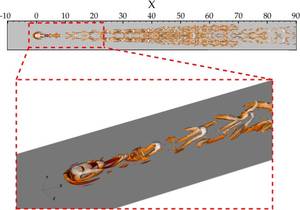Global analysis of flow over cylindrical roughness
May, the 11th, 2017 at 12:00 in Sala Consiglio of the DAER, 2nd Floor, Building B12, Campus Bovisa
Dipartimento di Scienze e Tecnologie Aerospaziali
Via La Masa 34
20156 Milano
DAER Seminar
Michele Alessandro Bucci
DynFluid, Arts et Métiers ParisTech, 151 Bd. de l'Hopital, 75013, Paris, France
Abstract
Tollmien-Schlichting waves in boundary-layer flows can be stabilised by the presence of streamwise-oriented streaks, consequently delaying transition to turbulence [1]. This behaviour is driven by the work of the uw-Reynolds stresses against the spanwise shear. This stabilisation effect has been demonstrated experimentally on the flow past a cylindrical roughness element installed at the wall. Although the cylindrical roughness element is able to generate a pattern of high- and low-speed streaks, it has recently been demonstrated that the separation zone behind the roughness element may induce a global instability of the flow [2]. Recent experiments in the IAG laboratory in Stuttgart University demonstrate that the flow can be unsteady before the critical threshold highlighted by the global stability analysis. The present work aims at investigating the effect of an external perturbation to the streaked boundary-layer receptivity. A new global stability analysis has been carried out employing a Krylov-Schur decomposition in the Nek5000 CFD code. The pseudospectra evaluated on the Hessenberg matrix shows a higher receptivity of the varicose mode with respect to the sinuous one [2]. A direct-adjoint loop [3] has been implemented to recover the structure of the optimal forcing associated to the most receptive pulsation. Optimal forcing at different amplitudes in the DNS calculation (figure 1) allows the same behaviours observed in the experiments to be recovered. It could be argued that these results are biased by the imposed pulsating forcing. For this reason, the Free-Stream Turbulence (FST) [4] has been implemented in the Nek5000 and used as uncontrolled external perturbation. The results show that a small turbulent intensity (Tu=0.18%) is sufficient to trigger the most receptive mode and yield to the same pulsation and stream-wise wavelength obtained by the optimal forcing analysis. A DMD [5] decomposition on the perturbed DNS is also performed and highlights how the spatial structure linked to the unsteadiness is very similar to the optimal response one. A physical explanation on the origin of hairpin vortices behind the roughness is also given (figure 1).

Figure 1) Varicose perturbation behind the cylindrical roughness induced by optimal forcing. Hairpin vortices triggered by the most receptive resolvent mode.
References:
[1] Carlo Cossu and Luca Brandt. Stabilization of tollmien-schlichting waves by finite amplitude optimal streaks in the blasius boundary layer. Physics of Fluids (1994-present), 14(8):L57-L60, 2002.
[2] Jean-Christophe Loiseau, Jean-Christophe Robinet, Stefania Cherubini, and Emmanuel Leriche. Investigation of the roughness-induced transition: global stability analyses and direct numerical simulations. 2014.
[3] Monokrousos, A., Ĺkervik, E., Brandt, L., & Henningson, D. S. (2010). Global three-dimensional optimal disturbances in the Blasius boundary-layer flow using time-steppers. Journal of Fluid Mechanics, 650, 181-214.
[4] Luca Brandt, Philipp Schlatter, and Dan S Henningson. Transition in boundary layers subject to free-stream turbulence. Journal of Fluid Mechanics, 517:167–198, 2004.
[5] Schmid, P. J. (2010). Dynamic mode decomposition of numerical and experimental data. Journal of fluid mechanics, 656, 5-28.
- Files:
 20170511_Bucci_LOC.pdf271 K
20170511_Bucci_LOC.pdf271 K
